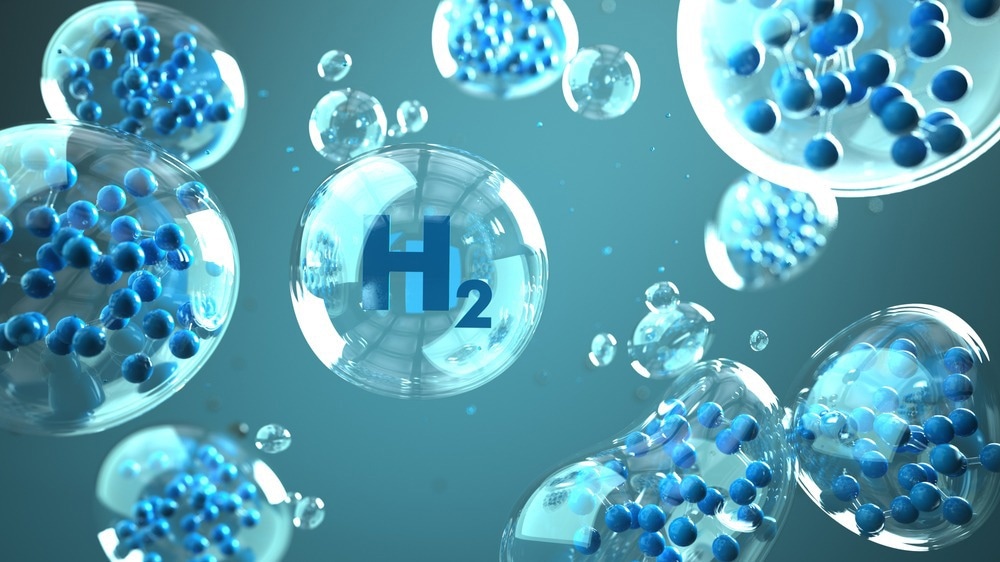Electrolysis is revolutionizing green hydrogen production, marking a new chapter in sustainable energy. This article illuminates its crucial role, weaving through the latest advancements, research breakthroughs, and challenges. It explores how electrolysis is not just an option but a necessity in the burgeoning realm of eco-friendly hydrogen fuel.

Image Credit: Alexander Limbach/Shutterstock.com
What Makes Electrolysis Essential for Green Hydrogen?
Electrolysis is essential for green hydrogen production due to its environmentally friendly and efficient process of splitting water into hydrogen and oxygen using electricity from renewable sources.
Different types of electrolyzers, such as Polymer Electrolyte Membrane (PEM), Alkaline, and Solid Oxide, cater to various operational scales and efficiencies.
PEM electrolyzers, for example, are well-suited for small-scale production, while Solid Oxide electrolyzers leverage high temperatures to reduce electrical energy needs. Furthermore, large-scale electrolytic hydrogen production is becoming increasingly cost-effective.
Costs could drop to 2 Euro per kg H₂ by 2040, approaching parity with traditional hydrogen production from natural gas, even considering historical natural gas prices. This affordability and low greenhouse gas emissions reinforce electrolysis as a sustainable and economically viable option in the energy transition (U.S. Department of Energy, 2022; Terlouw et al., 2022).
Innovations in Electrolysis Technology
Recent electrolysis technology advancements drive efficiency and scalability in green hydrogen production. A key innovation comes from the Georgia Institute of Technology, where researchers are developing hybrid materials for electrocatalysts to make green hydrogen less costly and more durable.
Traditional electrolysis relies on expensive noble metals like platinum and iridium, but the new approach aims to decrease the use of these metals, enhancing activity and utilization options. This innovation involves designing a new class of catalysts with a better oxide substrate that uses less noble elements, showing superior performance for oxygen and hydrogen splitting.
The research emphasizes the importance of the catalyst's shape in hydrogen production, focusing on controlling the shape and interaction of metals on the substrate material. This development is expected to lower the barrier of equipment cost in green hydrogen production, with potential applications in hydrogen stations for fuel cell electric vehicles and microgrids (Georgia Tech, 2022).
Overcoming Barriers to Electrolysis Adoption
Addressing the challenges in electrolysis adoption for hydrogen production is crucial for its widespread implementation. Key issues include reducing costs, developing efficient infrastructure, and managing energy requirements and environmental impact.
Current efforts focus on reducing costs to make electrolytic hydrogen production competitive with traditional methods. However, the feasibility of low-cost, low-emission electrolysis is limited to locations with abundant renewable energy resources. Producing larger system components, particularly PEM electrolyzers, also presents environmental and investment challenges.
According to Ji and Wang (2021), hydrogen production from renewable sources like water electrolysis is gaining traction due to its lower environmental impact. However, most hydrogen is currently produced from fossil fuels, primarily through natural gas steam reforming (SMR), which contributes over 45% of global hydrogen production.
This method, while more economical, poses significant environmental challenges. Electrolysis, although more environmentally benign, faces economic and efficiency challenges. The balance between economic feasibility and environmental sustainability is crucial in choosing the right hydrogen production method.
The scarcity of materials such as iridium poses significant constraints in scaling up green hydrogen production. These factors underscore the need for a holistic approach to developing large-scale hydrogen production systems, considering environmental, economic, and material aspects (Terlouw et al., 2022).
Electrolysis vs. Other Hydrogen Production Methods
Electrolysis, particularly low-temperature water electrolysis, is a key method for hydrogen production. It stands out for its lower emissions intensity compared to other routes. Hydrogen production from natural gas via steam methane reforming (SMR) or partial oxidation (POx) typically demands more energy.
In the case of no CO2 capture, SMR is based on 44.5 kWh/kg H2, and POx on 41 kWh/kg H2. On the other hand, electrolysis requires about 50 kWh/kg H2. This makes electrolysis a more sustainable option, particularly when coupled with renewable energy sources. Each method's efficiency and environmental impact vary, with electrolysis offering a cleaner but sometimes more energy-intensive alternative (IEA, 2023).
The Future of Electrolysis in Green Hydrogen Production
As the green hydrogen industry evolves, electrolysis stands at the forefront of sustainable energy innovation. Future developments are expected to enhance electrolysis efficiency and cost-effectiveness, aligning it closer with global energy sustainability goals.
Emerging trends include integrating renewable energy sources more seamlessly with electrolysis systems and advancing catalyst technologies to reduce reliance on rare materials. The industry is also focusing on scaling electrolysis for broader applications, overcoming current infrastructure and resource availability limitations.
As research continues, electrolysis is poised to become a more dominant method in hydrogen production, contributing significantly to reducing carbon emissions and fostering a cleaner energy future. This trajectory indicates a promising role for electrolysis in achieving global environmental targets and advancing renewable energy technologies.
References and Further Reading
Georgia Tech (2022). A Catalyst for More Efficient Green Hydrogen Production. [Online] Georgia Tech. Available at: https://research.gatech.edu/catalyst-more-efficient-green-hydrogen-production (Accessed on 19 December 2023).
IEA (2023). Comparison of the emissions intensity of different hydrogen production routes, 2021. [Online] IEA. Available at: https://www.iea.org/data-and-statistics/charts/comparison-of-the-emissions-intensity-of-different-hydrogen-production-routes-2021 (Accessed on 19 December 2023).
Ji, M. and Wang, J. (2021). Review and comparison of various hydrogen production methods based on costs and life cycle impact assessment indicators. International Journal of Hydrogen Energy, 46(78), pp. 38612-38635. https://doi.org/10.1016/j.ijhydene.2021.09.142.
Terlouw et al., (2022). Large-scale hydrogen production via water electrolysis: a techno-economic and environmental assessment. Energy & Environmental Science, 15, pp. 3583-3602. https://doi.org/10.1039/D2EE01023B.
U.S. Department of Energy, (2022). Hydrogen Production: Electrolysis. [Online] U.S. Department of Energy. Available at: https://www.energy.gov/eere/fuelcells/hydrogen-production-electrolysis (Accessed on 19 December 2023).
Disclaimer: The views expressed here are those of the author expressed in their private capacity and do not necessarily represent the views of AZoM.com Limited T/A AZoNetwork the owner and operator of this website. This disclaimer forms part of the Terms and conditions of use of this website.